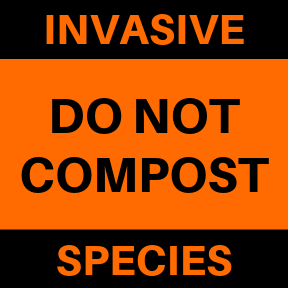

How to Dispose of Invasive Plant Material
Improper disposal of invasive species can lead to the further spread of invasives in the Sea to Sky. Many invasive plant parts (seeds, rhizomes) can withstand the composting process, so it is important to:
- Separate invasive plant material from yard waste
- Place invasive plant material in a bag, or on a tarp, & seal it
- Take to the transfer station/landfill
- DO NOT COMPOST!

Disposal Recommendations by Jurisdiction

Please refer to the information below for area-specific details on how to properly dispose of invasive plant material in each municipal or regional district area.
- RMOW – Invasive Species Disposal Recommendations
- DOS – Invasive Species Disposal Recommendations
- SLRD Area C & D – Invasive Species Disposal Recommendations – coming soon!
Illegal Dumping

Unfortunately, there are still issues with people disposing of soil, fill and yard waste, often containing invasive plants, illegally in the Sea to Sky. The Sea to Sky Illegal Garbage Dumping Map highlights some problem areas, many of which now have invasive species infestations from improperly disposed invasive plant material. Please be vigilant and report illegal dumping to local bylaw.
How to Manage Invasive Species

General Recommendations
- Learn to identify common invasive species by browsing our invasive plants, invasive animals and other organisms pages.
- Avoid planting invasive plants; beware of ‘wildflower’ mixes, which often contain invasives.
- Regularly monitor properties for infestations.
- Ensure soil and gravel are uncontaminated before transport.
- Don’t unload, park, or store equipment or vehicles in infested areas; remove plant material from any equipment, vehicles, or clothing used in such areas and wash equipment and vehicles at designated cleaning sites before leaving infested areas.
- Minimize soil disturbances (e.g., use grazing plans that prevent soil exposure from overgrazing), and use seed mixes with dense, early colonization (e.g., alfalfa or barley) to re-vegetate exposed soil and resist invasion.
- Ensure plants (particularly flowering heads or root fragments) are bagged or covered to prevent spread during transport to designated disposal sites (e.g., landfill). Do NOT compost.
- Clean, drain and dry all aquatic equipment and vessels.
- Don’t let it loose! Don’t release an unwanted pet into the wild.
- Do not capture animals, amphibians, invertebrates or insects and release them in an area where they do not naturally occur.

Species-specific Recommendations
Each species has unique characteristics, so control and management recommendations differ from one species to another. Please refer to our invasive plant, invasive animals and other organisms pages for more information, or contact us!


